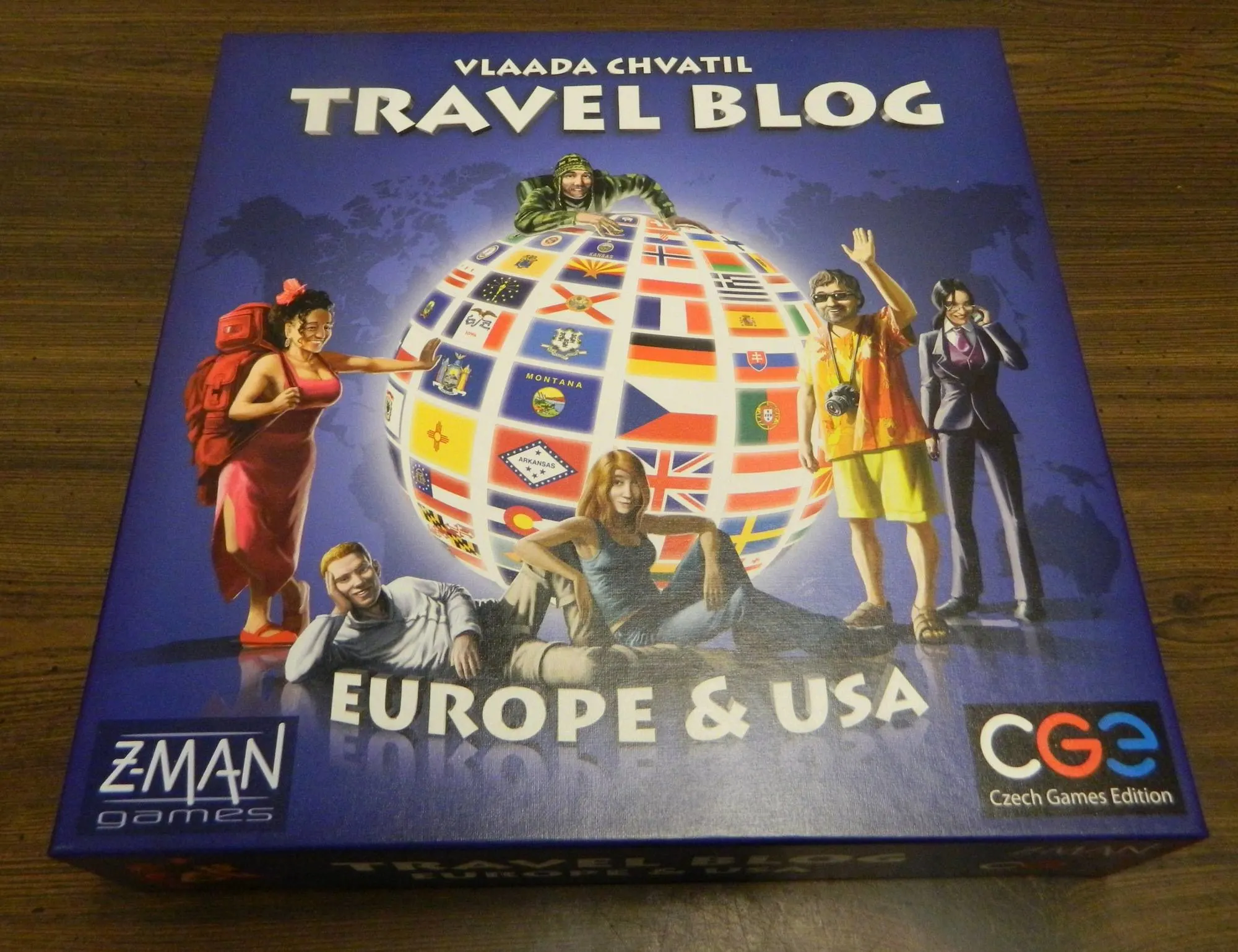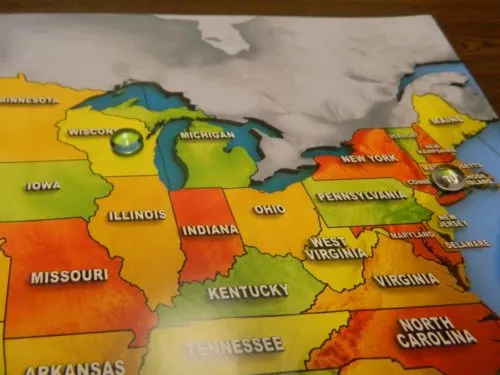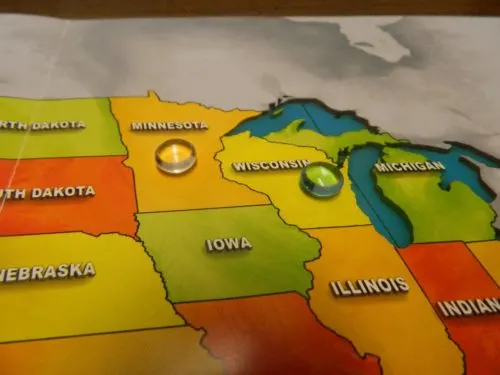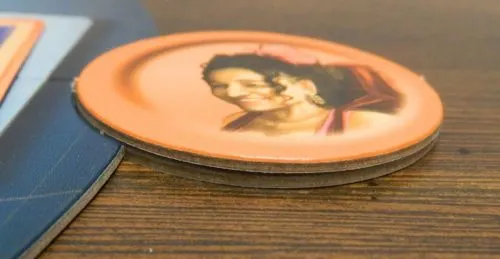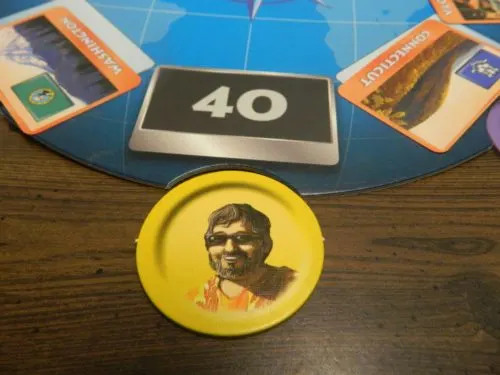Vlaada Chvátil has developed a reputation as one of the best board game designers in the industry. Having designed games like Codenames, Galaxy Trucker, Mage Knight, and Through the Ages; whenever I see a game that was designed by Vlaada Chvátil I am immediately interested. When I saw Travel Blog on clearance I decided to pick it up despite the fact that the Geography theme was not that compelling to me. While I think Travel Blog has some interesting mechanics, the game gets a little repetitive after a while and doesn’t live up to the other games designed by Vlaada Chvátil.
How to Play Travel Blog
Setup
- Choose whether you are going to use the Europe or USA map. Place the chosen map (face down) and the associated state/country cards (referred to as state cards for the rest of these rules) on the table. The other map and cards stay in the box.
- Place the gameboard in the center of the table where everyone can reach it.
- Shuffle the state cards and place them face down on the table.
- Each player chooses a color and takes the traveler card and tokens that match that color.
- Place the money and markers to the side of the board.
Playing the Game
Travel Blog is played in seven rounds. While the basic gameplay stays the same between the rounds, there are some tweaks to each round.
Rounds One and Two
At the beginning of round one all of the players will be given 100 euros.
The gameboard is turned so the 40 space is turned towards the player who is the dealer for the round. Each round begins with the dealer placing one state card face up on each space around the gameboard other than the space with 40 printed on it. The dealer then adds a card to the middle of the gameboard face up. The round then begins.
Each player should study all of the cards on the gameboard. The card in the middle is the state that the players will start from. Players should look at the other cards to find a state that is close to the starting state but doesn’t share a border with the starting state. States that have arrows pointing to other states are considered to share a border. If a player doesn’t think any of the states are close to the starting space they can choose the 40 space.
When a player has chosen their state they place one of their tokens on the state. If a player has already placed their token on the state, all other players have to place their token on top of the other players’ tokens. Once a token has been placed it cannot be moved to another space.
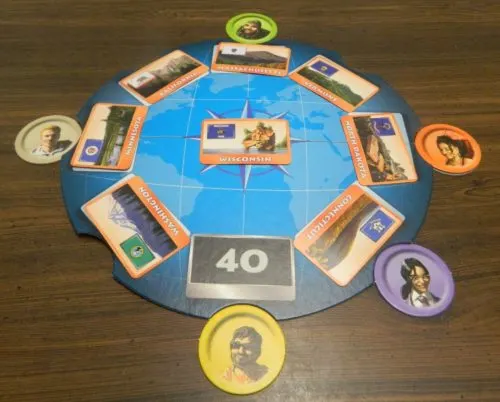
All of the players have chosen their state for the first round. The yellow player has chosen the 40 space. The purple player has chosen to create a path between Wisconsin and Connecticut. The blue and red players have chosen to connect Wisconsin to North Dakota. The green player has chosen to connect Wisconsin to Massachusetts. The tan player has chosen to connect Wisconsin to Minnesota.
Once everyone has placed their token, players will head to scoring. The map is turned face up so everyone can see it. Each player will individually score their own routes. Generally it is recommended to start with players whose token is on top of another token. Players use the markers to indicate the starting state and the destination state chosen by the player. Players will have to pay euros to the bank as follows:
- 10 euros for each border crossed on the map. The player who is being scored can choose whichever path they want in order to reduce their cost.
- 30 euros if the two states share a border.
- 10 euros for every token played below your token on the gameboard.
- If the player chose the 40 space they pay 40 euros and don’t have to travel. They still face the 10 euro penalty if their token is on top of another token.
Each player pays their cost to the bank. Once everyone has paid their cost, players will play round two in the same way. New state cards are dealt out, the map is flipped face down again and the next player clockwise becomes the dealer. In round two players do not get additional money. If a player ever runs out of money they pay all that they can and don’t owe any more money to the bank.
Rounds Three and Four
At the beginning of round three each player gets 200 euros from the bank. This money is added to any money left after round two.
In rounds three and four the cards are dealt out like in rounds one and two. The difference in rounds three and four is that each player will have to use both of their tokens to choose two states. The state in the middle of the gameboard is the starting state. The two states that the players choose have to be visited. The player can choose which of the two states they will visit first. The players can choose any two states/40 space but can’t place both tokens on the same space. All other rules about placing tokens are the same as the first two rounds.
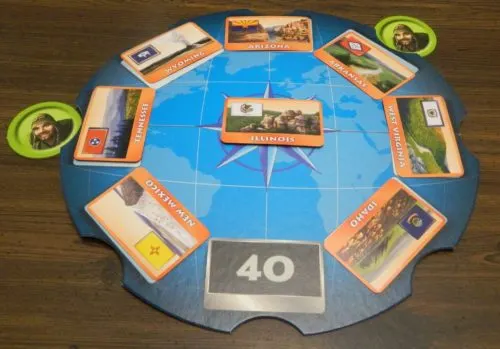
In this round the starting state is Illinois. The green player has chosen to also travel to Tennessee and Arkansas during the round.
Scoring is conducted in basically the same way as the first two rounds except that players have to visit two states. Players can choose to visit either of their chosen states first. Players will have to pay euros as follows:
- 10 euros for every border crossed.
- 30 euros for every shared border between the chosen states and/or the starting state.
- 10 euros for every token below each of your tokens.
- If you choose the 40 space you will only have to find a path between the starting state and the other state you choose. You will also pay 40 euros for choosing the 40 space.
After scoring, round four is played the same as round five with the board being reset.
Rounds Five and Six
At the beginning of round five each player is given 300 euros to add to the euros they have left from previous rounds.
In rounds five and six the dealer will deal out cards to each space and deal two cards to the center of the gameboard. One of the state cards in the middle of the gameboard will act as the player’s start state while the other state will act as the end state. Each player can individually choose which will be their start state and which will be their end state. Like in rounds three and four the players will use both of their tokens to choose two different states.
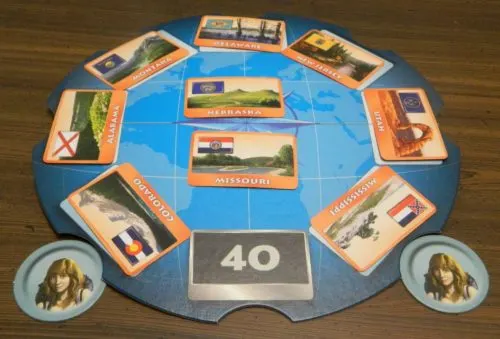
For this round the players get to choose between Nebraska and Missouri being the starting state while the other is the end state. The blue player has chosen Mississippi and Colorado to be the two states to visit between Nebraska and Missouri.
Scoring is conducted in the same way as rounds three and four. If the start and end states border one another though, the players are not assessed the 30 euro penalty.
Final Round
The final round is played a lot like rounds five and six but in reverse. Instead of trying to spend the least amount of money as possible, players are trying to rack up the largest bill they can since they will receive money from the bank equal to the amount of money they spend.
The same number of cards are put out onto the gameboard but you will have to shuffle the state cards before you deal them out. Players will choose two states to visit in between their start and end states. In order to reduce the amount of money the players receive, the other players will choose the path and start/end states for each player.
In this round you will earn euros as follows:
- You earn 10 euros for each border you cross.
- You earn 30 euros for each set of states that border one another. You will not receive money if the start and end state share a border though.
- You earn 40 euros if you place a token on the 40 space. You will only visit one state between the start and end state though.
- Players will still lose 10 euros for each token placed below theirs on the gameboard.
End of Game
The player with the most money at the end of the game wins. If more than one player has the most money, they share the victory.
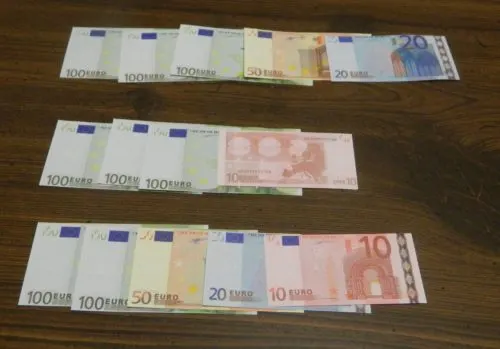
The top player has earned 370 euros, the middle player 310 euros, and the bottom player 280 euros. The top player has the most money so they won the game.
My Thoughts on Travel Blog
When most people first look at Travel Blog they will probably see an educational game. The gameplay is based around geography and the game even includes an information booklet that tells you about the different countries/states featured in the game. Being labeled with the educational title is generally not considered a positive for most board games as educational games are usually pretty dull. The problem with most educational games is that they are designed first to educate and then they try to add in the fun after the fact. Travel Blog differs from most educational games though because it was designed to be fun and the educational component was added afterwards.
Where Travel Blog differs from a lot of educational games is that it plays like a geography trivia game that was mixed with a speed game. Where most geography games would just ask trivia questions about various countries/states, the trivia aspect of Travel Blog is a based around location. Players are tasked with trying to recall where various states/countries appear on the map. Players are given a group of states/countries and they have to find other states/countries that are near each other but don’t actually share a border.
This is the type of mechanic I really like to see in educational games. While the game is educational it didn’t solely focus on that aspect of the game. The best educational games focus on the gameplay and then add in the educational elements. This allows the game to first and foremost be fun so it can teach the players while they are enjoying it. Travel Blog does a really good job with this as the game is fun but also quite educational. Travel Blog could work really well as a Geography teaching tool that is also enjoyable enough that you actually want to play it.
Other than the memory mechanics of visualizing where the states/countries are, the game relies on a speed mechanic. While the speed mechanic is probably not as important as being able to visualize the states/countries, it is still quite important to the game. The reason the speed mechanic is important is that it can save you quite a bit of money in the game. The first player to place a token on the best state card will save money over the other players that also choose the card. Ten euros might not seem like a lot but it adds up pretty quickly. You don’t want to rush too quickly though or you are going to end up making a mistake that will cost you even more.
While there are other games that have a similar mechanic of trying to find things that are close but not too close, Travel Blog deserves credit for creating a unique game experience. While I have played games that have had similar mechanics, I can’t recall playing a game that plays quite like Travel Blog. I have to say that this isn’t that surprising being created by a designer like Vlaada Chvátil. Vlaada Chvátil generally does a really good job figuring out new ways to use old mechanics.
Since it was designed as a family game, Travel Blog is a pretty easy game to pick up and play. The game’s mechanics are easy to grasp as you just have to place your tokens on one or two of the cards placed on the gameboard. Otherwise you have to deal with the scoring system which is really straightforward. The main reason I would say that the game has an age recommendation of 8+ is that children under that age probably won’t know enough geography to do much more than guess throughout the entire game.
While the game is quite easy to play, I have to say that I was a little surprised to see that the game is quite a bit harder to do well in then I was expecting. I wouldn’t consider myself to be a Geography expert but before playing the game I expected to do quite well in Travel Blog. Since we live in the USA we decided to use the USA map. I thought I would do really well in the game because I have good idea of where each state is located in the USA. It turns out that wasn’t as helpful as I was expecting.
I attribute Travel Blog being more difficult than I was expecting due to two things. Unless you are really good at visualizing the map in your head, knowing the general area of all of the states is not good enough. You can know that a state is on the west coast, east coast, etc but slightly misplacing a state could add quite a bit to your cost. When you add in the time crunch of racing against the other players this becomes even more difficult.
The thing that adds the most difficulty though is the rule where you are punished when you choose states that share a border. This penalty is actually a smart rule as it prevents players from trying to be too risky when choosing states. The penalty can be really costly though as getting the penalty is usually worse than picking another state card. This penalty can cost you the game because I was actually good at picking nearby states but ended up getting hit with the penalty too often which lead me to losing the game. Unless you are really good at picturing neighboring states you might be better off choosing states that you know are a little further apart just to avoid the penalty.
As I mentioned before we ended up playing with the USA map since being US residents made us more familiar with the map. I applaud Travel Blog for also including the Europe map as it gives players more variety in the game. I am kind of curious how much more difficult the Europe map would be for American players though. Being not as familiar with the map should make the game quite a bit more difficult. I think the same would also apply to Europeans with the USA map. I would recommend players start with the map that they are more familiar with but it might be interesting trying out the other map for more of a challenge.
While there are a lot of things that I liked about Travel Blog, there are some issues with the game.
One problem comes from the scoring. The scoring itself is not that difficult but it just takes too long in my opinion. Usually the scoring takes at least twice as long as the rest of the gameplay. The scoring takes so long because players have to find the most efficient route between the states you have to visit. For most players you are going to have to analyze a couple different routes to see which crosses the least number of borders. I can’t say that I am ever a fan of a scoring system that takes longer than the actual gameplay.
The other problem that I had with the game is that it just didn’t live up to my expectations. With how many groundbreaking games that Vlaada Chvátil has created I was just hoping for more from Travel Blog. The game is interesting and I had fun playing it. The problem is that it tends to get dull faster than you would like. The game starts to feel a little repetitive towards the end of the game. Basically I see playing one game of Travel Blog and then putting it away for quite a while before I would play another game.
A while back I took at look at the 10 Days series (10 Days in the USA, 10 Days in Africa) of board games designed by Alan Moon. I bring this up because as I was playing Travel Blog it reminded me a lot of the 10 Days series. That comparison makes sense as both games have the geography themed gameplay where players are planning a travel route around the United States/Europe/etc. I think the two games share more than just the theme though.
The main difference between the two games comes down to what each game emphasizes. Travel Blog seems to focus more on speed and memory while the 10 Days series has a bigger emphasis on strategy. Travel Blog has players trying to remember the map in their heads and claiming the best cards before the other players. Meanwhile 10 Days is more focused on the strategy of creating a travel itinerary which has players planning ahead about what path they want to take in the game.
While I can see people preferring the speed based gameplay of Travel Blog I personally have to say that I prefer the 10 Days series. The main reason that I prefer 10 Days is because it has more decision making/strategy involved. Your success in Travel Blog comes down to how fast you are and how good you are at visualizing Europe/USA in your head. In 10 Days there is no need for the memory aspect of the game. Instead you are just trying to find the most efficient travel route.
For the components there are some things that I enjoyed and some things that could have been better. As I already mentioned I really like that the game comes with both the Europe and USA map. Having two maps gives the game more variety. It doesn’t really change the gameplay but the two maps should play somewhat differently and will test your knowledge. While the play money is not fantastic it is better than you get with most board games. Otherwise a lot of the components are of a pretty typical quality. I will say that I was a little disappointed by the maps though as they are just sheets of paper. I would have preferred that they were made from cardboard so they wouldn’t be as flimsy.
Should You Buy Travel Blog?
When you first look at Travel Blog it kind of looks like an educational game. The main gameplay does rely on your geographic knowledge of Europe and the USA. Unlike most educational games though Travel Blog was designed for gameplay and then the educational mechanics were added in afterward. Travel Blog does a pretty good job creating a unique experience combining a geography trivia game with a speed game. I think the game would work well as an educational tool while still being fun. I will admit that the game is harder to succeed in than you would expect though as even if you know where the states/countries are located, it is hard to visually see where they are located in your head. Otherwise Travel Blog does have some problems with the scoring taking too long and the game getting a little repetitive after a while.
My recommendation for Travel Blog comes down to how much the game’s mechanics appeal to you. If the game doesn’t seem that interesting to you, I don’t think you will really like Travel Blog. If you think the idea behind the game sounds interesting it might be worth picking up if you can get a good deal. Finally if you have children and want a game to help them with their Geography, I think Travel Blog could work quite well for you.
If you would like to purchase Travel Blog you can find it online: Amazon, eBay

